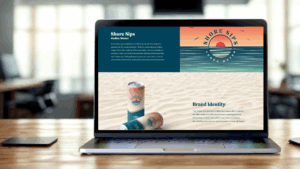Tracking eye movement can give us exciting insights into marketing and advertising while revealing a few things about human tendencies.
Are you a visual person? Many people can be swayed into purchasing a product by seeing only one enticing image if you provide them with the right one. Considering that we live in a world built upon digital technology, you have a thousand opportunities to provide a user with an image that is sure to be impressive.
To allow you to understand heat mapping, we are going to take you on an expedition that will provide you with a birds-eye view and some tips that will empower you to use heat maps to create your absolute best campaign.
Let’s get to it!
What is a heat map?
Let’s kick it off with the basics. A heat map is a two-dimensional representation of data in which many different values are represented by colors. Just a simple heat map can provide an immediate visual summary of information. The more elaborate the heat map, the more complex information can be understood.
This definition can come off as a little boring, however, if you are a visual person then a heat map speaks louder once you see it. No matter how the heat map is represented, there is one common theme amongst all of them – it uses colors to represent data.
For marketing purposes, we have come up with a much simpler definition. In a digital marketing context, a heat map is a visualization map allowing users to see where and how visitors interact with a webpage. The brighter or hotter an area is, the greater numbers of interactions are taking place in that area. Red areas have the most interactions and blue areas have less activity. The hotter and brighter areas are the ones that your customers are drawn to first and interact with, while colors like green and blue are the ones that are meant to stay in the background and compliment the red areas.
Why you should begin heat mapping?
A marketing strategy without metrics is coined a spending marketing strategy. It is crucial for you to have a firm grasp of how your marketing strategy develops and what color the interaction you have with your audience is.
Do you know what appealing thing will make your audience fall in love with your web page, tool or banner ad?

Here is where the heat map will come into play.
• Affection at first glance. Your potential customers do not have all day to sit around and scroll through your website, so their judgment is based on what catches their eye first. Make the first thing they see worth noticing. An example of this could be if your business is a restaurant. On your website, you can provide an image of a sizzling steak right in the center of the page to draw in the visitors and entice them to see what your restaurant has to offer.
• Banner blindness. It will be leaps and bounds easier to control what people pay attention to and what completely slides right past them. With the assistance of heat maps, you will be aware of what people avoid as well as have a second chance at repositioning a banner or segment on your website so that you will impress the next member of your audience.
• Value the metrics. These numbers will reflect how beneficial an ad, marketing campaign, or any other kind of spending went. You will be able to visualize where you went wrong, learn how to fix it, and improve your conversion rate in the future.
Take down the F-pattern
Every day, there are approximately two million blog posts that are put on the web and over one trillion pages across the worldwide web. Needless to say, we’ve got a ton of reading to do. The human brain instantly was turned away from having to do all of that reading and the dreaded f-pattern came to life.
Now that we are aware of how detrimental the f-pattern can be, our team at Adapting Social crafted the perfect plan to take it down.
Step 1: Stop imagining that users are reading every last bit and piece of information that you provide them with. Give them straightforward and easy to understand the content.
Step 2: The two first paragraphs are everything. Provide them with information that is engaging and consistent so that they are inspired to read it all.
Step 3: Bullet points, subheadings, and paragraphs make reading much more tolerable.

Tracking with a heat map
Depending on what your overall goal is, one of these three options will easily work for you.
• In order to see where your visitors are looking, you can use eye-tracking tools. There has been a ton of research showing that eye movement and the movement of a mouse cursor is highly correlated. This can allow you to monitor what portions of your design are drawing in the eyes of potential customers and where you can implement more information. This will enhance the experience that your users have.
• Want to know what areas of your website work and what areas don’t? Utilize click-tracking tools. The clicking can be on a button, image, or text that is actually a link. The enchantment of this lies in the fact that you can immediately insert a link where people click the most. Without a click-tracking map, there is no way for you to know where people are clicking!
• Blindly scrolling around on a page is common, so to show where most of this scrolling is taking place you can utilize a scroll heat map. A scroll map will allow a user to visualize what kind of behavior your visitors have. This will show if they spend a lot of time on the top of your page, in the middle, and if users eventually scroll to the bottom.

Heat maps and marketing
Heat mapping tools will give you an image worth a thousand-paper report. This map will be easier to explain to your entire marketing team about how your page or ad is working, what needs to be enhanced, and what just flat out is not working.
A. The Call-to-Action
Imagine this, you installed a call-to-action button or banner right on your website and it just is not converting the way that you would want because there are just way too many distractions on your website. Do people flat out ignore your call-to-action, or do they just click somewhere else instead? The proof lies within your heat map. A potential way to avoid this is to just redesign your page based on the results of your map.
B. Directional Cues
In banner advertising, it is not just a background image; it is a background image that will directly benefit your call-to-action.
When it comes to taking your marketing to the next level, you always want to make the most out of your website, campaigns, and advertisements. A fantastic way to visualize how these components are doing is by tracking information through heat mapping. At Adapting Social, we believe in utilizing any tools available in order to obtain information from visitors to maximize their experiences.













